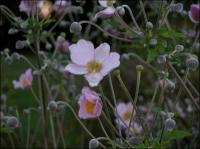Description
Pearl-like buds open to single, ballerina- pink umbels in late summer and fall.
Pearl-like buds open to single, ballerina- pink umbels in late summer and fall
Pearl-like buds open to single, ballerina- pink umbels in late summer and fall.
Purple, upfacing bells for months in mid to late summer
Size: 4-6” x 20”
Care: full sun-part shade in moist well-drained soil
Native: Northern Yugoslavia
Awards: England’s Royal Horticultural Society Award of Merit. Top rated for ornamental traits and landscape performance by the Chicago Botanic Garden & Elisabeth Carey Miller Botanical Garden Great Plant Pick.
Campanula is Latin meaning “little bell.” This species named for one of its discoverers, Franz Edler von Portenschlag-Ledermayer (1772-1822). 1st described in Systema Vegetabilium 5: 93 in 1819
Small crimson-red bells dangle from July to September
Size: 8’ x 3’
Care: Full sun in humusy, fertile, moist well-drained soil. Mulch around the base. Flowers on current year’s stems so cut back to 6-8” in late winter or early spring.
The genus Clematis was named by Dioscordes, physician in Nero’s army, from klema meaning “climbing plant.” The species 1st collected by the “Father of Texas Botany” Ferdinand Lindheimer in 1830’s. Max Leichtlin of the Baden Botanic Garden sent C. texensis to Kew Botanic Garden in London in 1880. French nurseryman Francisque Morel sent this selection to William Robinson. Robinson named it for his English nursery at Gravetye Manor in 1914
Balloon shaped buds opening to white bells in mid-summer to early fall.
Size: 24" x 12"
Care: Full sun to part shade in moist well-drained soil. Heat and drought tolerant. Deadhead for rebloom.
Native: Eastern Asia
Wildlife Value: attracts hummingbirds, bees & butterflies
Awards: England's Royal Horticultural Society Award of Garden Merit.
Platycodon is Greek from platys meaning “broad” and kodon meaning “bell”, referring to the shape of the flower. Cultivated in China for hundreds of years where it is called Jie-geng. Chinese used the root boiled to cure a chill in the stomach. Mentioned in Man’yoshu, a Japanese anthology of poems written in the 8th century. German botanist Johann Gmelin (1709-1755) collected P. grandiflorus in Siberia in 1754. Gmelin’s Siberian mission, sponsored by Catherine the Great, took 10 years and nearly killed him. Gmelin introduced it to European garden cultivation by 1782. Robert Fortune found the white form in a nursery near Shanghai and sent it to England in 1845.
Small purple flowers atop tall leafless stems from July to October. Great see-through blooms for growing in back, middle or front of the garden.
Size: 3-4’ x 8”
Care: full sun in moist, well-drained, fertile soil - self-seeder
Native: South America
Awards: Royal Horticultural Society Award of Merit & Missouri Botanic Garden Plant of Merit.
Introduced to garden cultivation from its native Buenos Aires in 1726 by the Sherard brothers.

